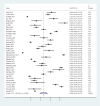The Prevalence and Associated Factors of Post-COVID-19 Fatigue: A Systematic Review and Meta-Analysis
- PMID: 39092372
- PMCID: PMC11293054
- DOI: 10.7759/cureus.63656
The Prevalence and Associated Factors of Post-COVID-19 Fatigue: A Systematic Review and Meta-Analysis
Abstract
After the coronavirus disease 2019 (COVID-19) pandemic, numerous individuals experienced the enduring consequences of infection. One of the psychological symptoms that patients report most frequently is persistent fatigue, which is also called post-COVID-19 fatigue. This persistent fatigue can prolong recovery time for hospitalized patients and reduce exercise motivation for residents, affecting their health and working conditions. To determine the prevalence and associated factors, we conducted searches in PubMed, Embase, Web of Science, and Cochrane Library, from inception to 27 March 2023, and a total of 38 studies and 17,738 patients were included in this analysis. We analyzed data and estimated publication bias by Egger's test and funnel plot by STATA 14. We summarized the prevalence of post-COVID-19 fatigue and calculated the pooled OR to determine associated factors. This study revealed that the prevalence of fatigue in post-COVID-19 syndrome was 46.6% (95% CI: 38.5%-54.7%). Being female (OR: 0.40, 95% CI: 0.24-0.56), older age (OR: 0.04, 95% CI: 0.01-0.07), clinical severity (OR: 0.66, 95% CI: 0.24-1.09), the number of acute COVID symptoms (OR: 3.23, 95% CI: 1.83-5.69), preexisting hypertension (OR: 1.24, 95% CI: 1.08-1.42), lung disease (OR: 2.71, 95% CI: 1.07-6.89), and depression (OR: 1.55, 95% CI: 1.01-2.39) were risk factors for post-COVID-19 fatigue. By revealing the association of these factors with fatigue, it can help us to identify and treat post-COVID-19 fatigue early.
Keywords: covid-19; meta-analysis; post-covid-19 fatigue; prevalence; systematic review.
Copyright © 2024, Hu et al.
Conflict of interest statement
Conflicts of interest: In compliance with the ICMJE uniform disclosure form, all authors declare the following: Payment/services info: All authors have declared that no financial support was received from any organization for the submitted work. Financial relationships: All authors have declared that they have no financial relationships at present or within the previous three years with any organizations that might have an interest in the submitted work. Other relationships: All authors have declared that there are no other relationships or activities that could appear to have influenced the submitted work.
Figures








Similar articles
-
Global prevalence and risk factors of fatigue and post-infectious fatigue among patients with dengue: a systematic review and meta-analysis.EClinicalMedicine. 2024 Dec 31;80:103041. doi: 10.1016/j.eclinm.2024.103041. eCollection 2025 Feb. EClinicalMedicine. 2024. PMID: 39844930 Free PMC article.
-
Psychiatric and neuropsychiatric presentations associated with severe coronavirus infections: a systematic review and meta-analysis with comparison to the COVID-19 pandemic.Lancet Psychiatry. 2020 Jul;7(7):611-627. doi: 10.1016/S2215-0366(20)30203-0. Epub 2020 May 18. Lancet Psychiatry. 2020. PMID: 32437679 Free PMC article.
-
Global prevalence of COVID-19-induced acute respiratory distress syndrome: systematic review and meta-analysis.Syst Rev. 2023 Nov 13;12(1):212. doi: 10.1186/s13643-023-02377-0. Syst Rev. 2023. PMID: 37957723 Free PMC article.
-
Global prevalence of chronic fatigue syndrome among long COVID-19 patients: A systematic review and meta-analysis.Biopsychosoc Med. 2022 Oct 23;16(1):21. doi: 10.1186/s13030-022-00250-5. Biopsychosoc Med. 2022. PMID: 36274177 Free PMC article.
-
Association Between Mood Disorders and Risk of COVID-19 Infection, Hospitalization, and Death: A Systematic Review and Meta-analysis.JAMA Psychiatry. 2021 Oct 1;78(10):1079-1091. doi: 10.1001/jamapsychiatry.2021.1818. JAMA Psychiatry. 2021. PMID: 34319365 Free PMC article.
Cited by
-
Global prevalence and risk factors of fatigue and post-infectious fatigue among patients with dengue: a systematic review and meta-analysis.EClinicalMedicine. 2024 Dec 31;80:103041. doi: 10.1016/j.eclinm.2024.103041. eCollection 2025 Feb. EClinicalMedicine. 2024. PMID: 39844930 Free PMC article.
-
Assessing Neuropsychiatric Symptoms in Long COVID: A Retrospective Cohort Study from a South Texas Long COVID Clinic.medRxiv [Preprint]. 2025 Jun 16:2024.11.03.24316669. doi: 10.1101/2024.11.03.24316669. medRxiv. 2025. Update in: Front Neurol. 2025 Jul 23;16:1612489. doi: 10.3389/fneur.2025.1612489. PMID: 40585077 Free PMC article. Updated. Preprint.
-
Neuropsychiatric symptoms cluster as primary drivers of Long COVID complexity: a South Texas retrospective cohort study.Front Neurol. 2025 Jul 23;16:1612489. doi: 10.3389/fneur.2025.1612489. eCollection 2025. Front Neurol. 2025. PMID: 40771985 Free PMC article.
-
Correlation between fatigue and pulmonary involvement in the post-COVID-19 condition: a cross-sectional study 6-12 months after hospital discharge.BMJ Open. 2025 Jul 13;15(7):e097338. doi: 10.1136/bmjopen-2024-097338. BMJ Open. 2025. PMID: 40659409 Free PMC article.
-
Elevated risk of new-onset chronic fatigue syndrome/myalgic encephalomyelitis up to four years after SARS-CoV-2 infection.J Transl Med. 2025 Jul 23;23(1):815. doi: 10.1186/s12967-025-06625-w. J Transl Med. 2025. PMID: 40702518 Free PMC article.
References
Publication types
LinkOut - more resources
Full Text Sources
